Scientific happenings, big and small, on this day in history
First, let’s get started with today’s quiz:
What common household item, used in more than 90 percent of American homes, was developed on this day in 1930 by Richard G. Drew? As a little hint, despite its name it did not originate in Scotland. The answer can be found at the end of this article.
In the meantime, here are some other significant happenings that have occurred on this day:
1504
Michelangelo's David is unveiled in Florence
In autumn 1504 the citizens of Florence, Italy witnessed an exceptional event. After four days of traveling around the city inside a wooden cage running on greased beams, Michelangelo’s David finally reached its destination: the Piazza della Signoria. It was immediately celebrated as one of the greatest masterpieces of the Renaissance. The statue was first intended to be displayed in the Cathedral, but was then felt to be of such great merit that it deserved a much more important position.
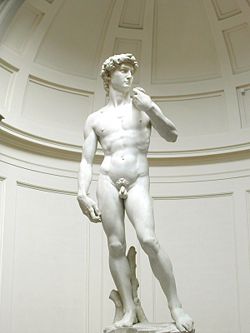
The history of David statue precedes Michelangelo's work on it from 1500-1504. Prior to Michelangelo's involvement, the Operai had plans to commission a series of twelve large Old Testament sculptures for the buttresses of the cathedral of Santa Maria del Fiore. Until then only two had been created independently by Donatello and his assistant, Agostino di Duccio. Eager to continue their project, in 1464 they contracted Agostino to create a sculpture of David. He only got as far as beginning to shape the legs, feet and the figure, roughing out some drapery, and probably gouging a hole between the legs. His association with the project ceased for reasons unknown, with the death of his master Donatello in 1466. Antonio Rossellino was commissioned to take up where Agostino had left off. However, Rossellino's contract was terminated soon thereafter, and the block of marble remained neglected for twenty-five years; all the while exposed to the elements in the yard of the cathedral workshop.
The rain and wind weathered it down to a smaller size than was originally planned. This was of great concern to the Operai authorities, as such a large piece of marble was both costly, and represented a large amount of labor and difficulty in its transportation to Florence. The Operai were determined to find an artist who could take this large piece of marble and turn it into a finished work of art. They ordered the block of stone, which they called The Giant, "raised on its feet" so that a master experienced in this kind of work might examine it and express an opinion. Though Leonardo da Vinci and others were consulted, it was young Michelangelo, only twenty-six years old, who convinced the Operai that he deserved the commission. On August 16, 1501, Michelangelo was given the official contract to undertake this challenging new task. He began carving the statue early in the morning on Monday, September 13, a month after he was awarded the contract. He would work on the massive biblical hero for a little more than three years.
The Florentines, who called it Michelangelo’s "giant", considered it the most explicit example of the spirit of the New Republic that had chased the Medici from Florence in 1494. Michelangelo’s David was so successful that he was called back to Rome by the Pope himself, Giulio II, for whom he would then paint the famous Sistine Chapel.
http://www.italyguides.it/us/florence/michelangelo_david.htm
1854
Dr. John Snow removed the handle of the Broad Street water pump in London, effectively halting further spread of cholera
John Snow (1813-1858) was apprenticed to a surgeon during the London Cholera epidemic of 1831-1832. In 1849 Snow published a small pamphlet "On the Mode of Communication of Cholera" where he proposed that the "Cholera Poison" reproduced in the human body and was spread through the contamination of food or water. This theory was opposed to the more commonly accepted idea that Cholera, like all diseases, was transmitted through inhalation of contaminated vapors. Although he was awarded for this work, without the technology and knowledge that we have today, Snow had no way to prove his theory.
It wasn't until 1854, when Cholera struck England once again, that Snow was able to legitimate his argument that Cholera was spread through contaminated food or water.
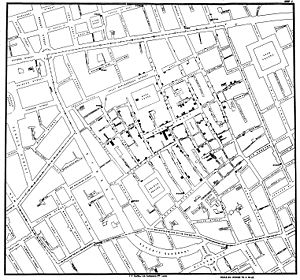
Snow, in investigating the epidemic, began plotting the location of deaths related to Cholera. At the time, London was supplied its water by two water companies. One of these companies pulled its water out of the Thames River upstream of the main city while the second pulled its water from the river downstream from the city. A higher concentration of Cholera was found in the region of town supplied by the water company that drew its water from the downstream location. Water from this source could have been contaminated by the city's sewage. Furthermore, he found that in one particular location near the intersection of Cambridge and Broad Street, up to 500 deaths from Cholera occurred within 10 days.
After the panic-stricken officials followed Snow's advice to remove the handle of the Broad Street Pump that supplied the water to this neighborhood, the epidemic was contained. Through mapping the locations of deaths related to Cholera, Snow was able to pinpoint one of the major sources of causation of the disease and support his argument relating to the spread of Cholera.
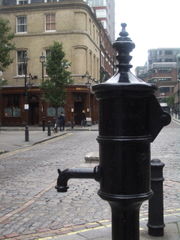
There is a plaque commemorating Snow and his 1854 study in the place of the water pump on Broad Street (now Broadwick Street), along with a symbolic water pump with its handle removed.
Snow's classic study offers one of the most convincing arguments of the value of understanding and resolving a social problem through the use of spatial analysis. While mapping has become a standard research approach in medical geography and epidemiology, today's researchers express the incidence of disease as a rate relative to the population or to the population within age cohorts (e.g., deaths per 1,000 population) so as to factor out the influence of population density. Using such refinements to the methods employed by Snow, mapping and spatial statistical techniques assist medical practitioners in understanding the diffusion and spread of diseases within communities and across the globe.
http://www.csiss.org/classics/content/8htm
1900
A powerful hurricane, the greatest natural disaster to ever strike the United States, hits Galveston, Texas
In the early evening hours of September 8, a hurricane came ashore at Galveston bringing with it a great storm surge that inundated most of Galveston Island and the city of Galveston. As a result, much of the city was destroyed and at least 8,000 people were killed in a few hours time.
Galvestonians had been aware of the storm since September 4, when it was reported moving northward over Cuba. However, from the very outset, details had been sketchy because of poor communications. Ships at sea, where oncoming hurricanes built strength, had no way of telegraphing weather observations ashore -- and other nineteenth-century technical shortcomings interfered.
Except for the rain and wind, Saturday began in the city of 38,000 inhabitants much the same as any other weekday. However the tide kept crashing farther inland, and the wind steadily increased. The Weather Bureau official in charge locally, Isaac M. Cline, drove a horse-drawn cart around low areas warning people to leave. Unfortunately, comparatively few people had evacuated the city before bridges from Galveston Island to the mainland fell. And many people along the beach waited until too late to seek shelter in large buildings in a safer area downtown, away from the Gulf.
Houses near the beach began falling first. The storm lifted debris from one row of buildings and hurled it against the next row until eventually two-thirds of the city, then the fourth largest in Texas, had been destroyed. The greatest wind velocity registered before the anemometer blew away at 5:15 P.M. was an average of eighty-four miles an hour for a five-minute period -- but gusts of 100 miles an hour had been recorded, and weathermen's estimates later reached more than 120 miles an hour.
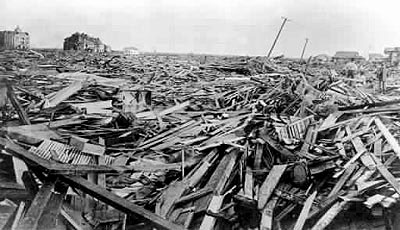
About 6:30 P.M. a storm wave, sweeping ashore in advance of the hurricane's vortex, caused a sudden rise of four feet in water depth. Shortly afterward the entire city was underwater to a maximum depth of fifteen feet. This storm wave caused much of the damage.
September 9 dawned on desolation. Most of the city lay in shambles. Over 8,000 people in the city of Galveston had died, and estimated casualties for the entire island ranged from 10,000 to 12,000. Property damage is impossible to estimate by current standards, but contemporary figures ranged from twenty to thirty million dollars. A high-water mark of 15.7 feet and high winds had destroyed a third of the city, including 2,636 houses and 300 feet or 1,500 acres of shoreline. More violent and costlier hurricanes have struck coastal areas of the United States since 1900, but because of the death toll, the Galveston storm was called the worst recorded natural disaster ever to strike the North American continent.
To prevent future storms from causing destruction like that of the 1900 hurricane, many improvements to the island were made. The first 3 miles of the 17-foot high Galveston Seawall were built beginning in 1902. An all-weather bridge was constructed to the mainland to replace the ones destroyed in the storm.
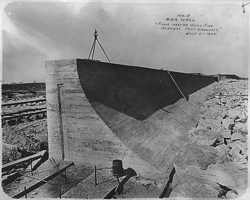
The most dramatic effort to protect the city was its raising. Dredged sand was used to raise the city of Galveston by as much as 17 feet above its previous elevation. Over 2,100 buildings were raised in the process, including the 3,000-ton St. Patrick’s Church. The seawall and raising of the island were jointly named a National Historical Civil Engineering Landmark by the American Society of Civil Engineers in 2001.
http://www.tshaonline.org/handbook/online/articles/GG/ydg2_print.html htm
And Coming… in 2040
In 2040, the first visible conjunction during the 21st century of the crescent Moon with the five naked-eye visible planets will occur.
The five naked-eye planets cluster together in the sky within a circle 25 degrees or less in diameter once every 57 years, on average. The 2040 grouping will include Mercury, Venus, Mars, Jupiter, Saturn and the crescent Moon. Clustered well to the east of the Sun, the planets will stage a spectacular show in the early evening.
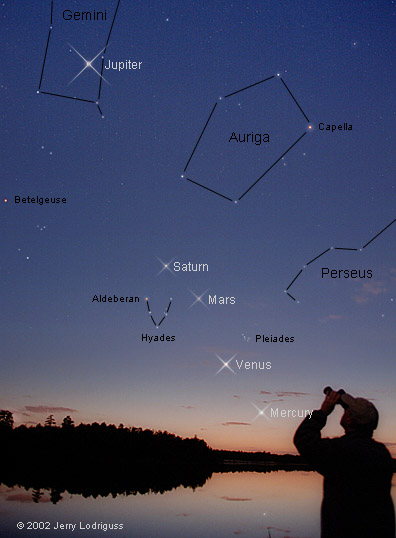
Many people believe that when planets are aligned their gravity and tidal forces are magnified, leading to extraordinary effects here on Earth. This seems reasonable. After all, "spring tides" (peak ocean tides that arise bi-monthly) occur when the Sun, the Moon and the Earth are nearly in a straight line around the times of the New Moon and Full Moon. Shouldn't even more powerful tides arise when lots of planets are lined up?
Fortunately, it doesn’t work that way. The maximum tidal force that each planet has on the Earth can be calculated. Tidal effects depend on distance and mass--but especially distance. Tides decrease in intensity as the cube of the distance to the source of gravity. (If you move twice as far away from a planet, its tidal force decreases by 2 cubed = 8 times). That's why the strongest Earthly tides are caused by the nearest object -- the Moon. If all the planets were to align perfectly with each one as close as possible to the Earth, their gravity would raise the ocean tides by just one twenty-fifth of one millimeter. Typical ocean tides on Earth caused by the Moon and Sun are thousands of times larger than that. Clearly, the contribution of the planets is entirely negligible, and it makes no difference to the Earth whether they are aligned or not.
So have no fear, it’s not the end of the world as we know it – just a fantastic night-time show. Mark your calendars!
http://science.nasa.gov/headlines/y2000/ast30mar_1m.htm
And the answer to today’s quiz?
The common household item, developed on this day in 1930 by Richard G. Drew?
Scotch tape.
The precursor to the current tapes was developed in Minneapolis by Richard Drew of 3M, to seal a then-new transparent material known as cellophane.
Use of the term "Scotch" in the name has a derogatory origin. To cut costs, 3M applied the adhesive only to the edges of the tape. A remark was made by a St. Paul automobile detailer that the stingy "Scotch" bosses needed to put more adhesive on it, and the name has stuck ever since. Scotty McTape, a kilt-wearing cartoon boy, was the brand's mascot for two decades, first appearing in 1944.

Today, 3M makes more than 900 varieties of Scotch brand tapes. Each year, 3M sells enough Scotch tape to circle the Earth 165 times.






Comments